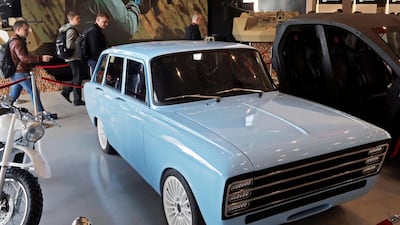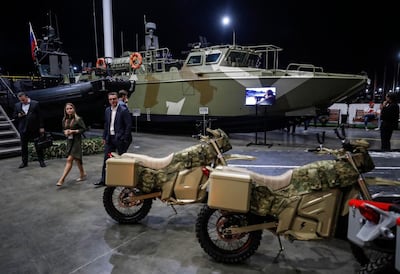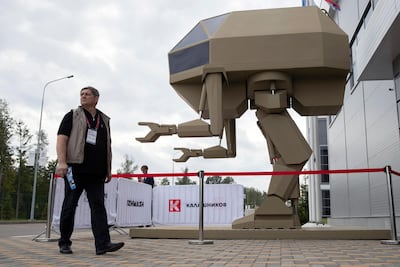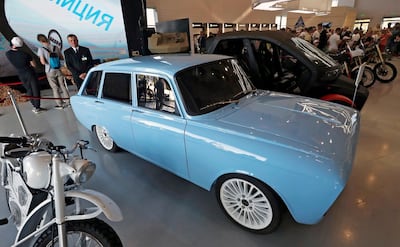It’s easy to laugh at the goofy prototype of an electric vehicle that the Russian company Kalashnikov is billing as a competitor to Tesla.
Yet there is a serious story behind the surprising recent turnaround of the vehicle’s maker, the creator of the AK-47 assault rifle.
The CV-1 prototype was introduced at the Russian Defence Ministry’s annual exhibition this year. It has the body of an Izh Kombi, a clunker made in Izhevsk, where Kalashnikov is based, between 1973 and 1997. The electric vehicle looks like it was designed to fit a popular Russian meme used to describe clumsy technology and lifehacks: “Whadja think of that, Elon Musk?”
But Kalashnikov probably won’t even try to mass-produce the car. The prototype is just a way to draw attention to the company’s bold diversification away from guns. It makes and sells other electric vehicles, too, including UM-1 electric motorbikes and the UV-4 electric four-wheeler.
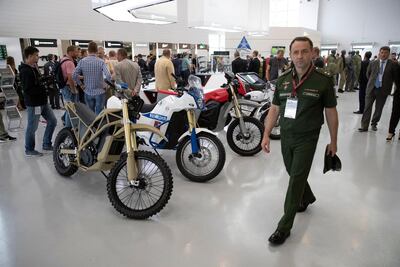
In 2013, two businessmen, Andrei Bokarev, whose company makes rail carriages, and Alexei Krivoruchko, who headed the successful firm that operates trains between Moscow airports and the city centre, were allowed to buy into Kalashnikov, then a loss-making state-owned company. Mr Krivoruchko became the chief executive. "People were making stuff, but they didn't know why," he recalled in a 2016 Forbes Russia interview. "Up until 2014 the company didn't make any new products, the latest one had been on the assembly line for 20 years."
Despite its globally known brand, Kalashnikov’s exports were weak: simple and reliable AK submachine guns are made the world over without a licence. The Russian military didn’t trust the company and had cancelled an important contract. Demotivated workers were making tiny salaries; engineers continued to invent new products, but the production side showed no interest in them in the absence of sales and marketing functions. It was a Soviet enterprise transplanted to the 21st century.
Mr Krivoruchko cut costs, hired marketers and salespeople, put the engineers’ new designs into production and started a chain of small acquisitions to expand into drones and military speedboats.
Kalashnikov was hit with US sanctions in 2014 after the Crimea annexation and lost the lucrative US market for its guns, which accounted for about 70 per cent of its firearm sales. Yet the company showed a profit in 2015 after years of losses.
The billionaire Iskander Makhmudov bought a stake in Kalashnikov, reducing the state holding to a minority one. In 2017, Mr Makhmudov and Mr Bokarev sold their stakes to Mr Krivoruchko, who became the controlling shareholder with 75 per cent of the company.
_______________
Read more:
Opec exit strategy and electric vehicles to set the energy tone for 2018
Darker side of electric cars in spotlight
_______________
In 2017, sales reached 14 billion roubles (Dh763.8 million at the current exchange rate); this year, revenue is projected to reach 22.5bn roubles.
Most of the money is from guns, sold on the domestic market and exported to about 20 countries. But Mr Krivoruchko has eye-catching ambitions beyond the drones and the boats. He has even tried to make a line of hunting clothes. This hunger for attention helps to explain the electric vehicles and an equally weird exhibit at the 2018 Defence Ministry expo, a 4.5-tonne manned walking robot meant for the military.
Mr Kalashnikov will happily take the free publicity, even when it comes with mockery. Since June, the company has been run by its former marketing director, Vladimir Dmitriev. Mr Krivoruchko was appointed deputy defence minister for arms procurement – a potential conflict of interest, but also an opportunity to fix Russia’s problem-ridden defence industry.
Could a sanctioned Russian gun maker with a grim Soviet legacy take on Tesla? The idea is laughable, of course. But Mr Kalashnikov’s trolling of the US brand helps to turn customers’ attention to an unusual story of a flexible, agile Russian private enterprise that broke away from an unwieldy state-owned corporation, Rostech, to start making money and looking for global markets for its low-cost engineering.
In an economy dominated by giants such as Rostech, Mr Krivoruchko’s achievements at Kalashnikov are a model for what could happen with a bit more space for private daring.
Bloomberg
